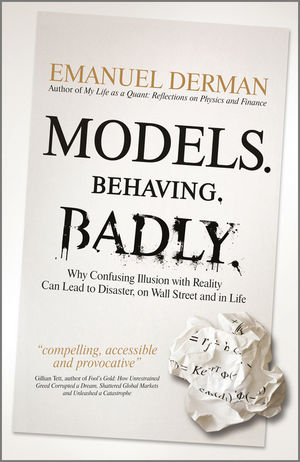Why confusing illusion with reality can lead to disaster, on Wall Street and in life.
 Note that the cover is more clever than you might at first notice. Ceci n’est pas une pipe.
Note that the cover is more clever than you might at first notice. Ceci n’est pas une pipe.
You might also have a guess at the reason for the punctuation in the title.
Executive summary
Non-quants should embrace models more, quants should distance themselves more.
Audience
This is not just another quant book written by a quant nerd. It is suitable for everyone, but — as stated above — the message is different depending on where you’re starting.
The real topic is approached obliquely. The book is telling us that things that we want to make simple are actually complicated. Finesse is in order. When you have the urge to skim a section, that is probably a sign that you should read that part most carefully — and wonder why it’s there.
Models are mandatory
There is a lot of noise about how models have caused economic turmoil. The key point of the book is that we have no choice but to use models. Given that our brain creates a model for what we see, it shouldn’t be surprising that we have to use models for less fundamental endeavors.
The question is not “Do I use a model?” but rather “How aware am I of the model and its limitations?”.
Resist addiction
Once we know what model we are using, we need to avoid abusing it by thinking it is real.
All models are wrong, some models are useful.
— George Box
We should believe that the model is both right and wrong.
Efficient Market Model
The book suggests — rightly, I think — that the Efficient Market Hypothesis should be called the Efficient Market Model.
since it’s a model of a hypothetical world rather than a correct hypothesis about the one we inhabit.
CAPM
It is a sign of the political power of models that commercial websites publish the value of beta, a parameter in a model that doesn’t work that well, but not the more fundamental and model-neutral volatility statistic sigma.
Favorite sentence
… technical analysis, a combination of rational and magical thinking that involves spotting the repetition of patterns in the trajectory of stock prices.
In closing
Models are only models, not the thing in itself. Models are better regarded as a collection of parallel thought universes to explore.
Epilogue
Everything I’ve ever told you has been a lie, including that.
the devil in “Bedazzled”

Pingback: Monday links: muddle through economics | Abnormal Returns
Nice, succinct review of an important, under appreciated issue.
This challenge of recognizing our illusions is relentless. Even mean-variance based modeling — the backbone of quantitative finance — rests on the typically ignored assumption of the choice of time period used for the calculation of the price variability. Choosing different time periods from minutes to months yields vastly different variance estimates. Yet we disregard the chaotic nature of complex natural systems and are content with an arbitrary, more “model-neutral volatility statistic sigma”.
In fact, the concept of price itself is probably severely mis-characterized as the intersection of supply and demand curves. Even where the market parameters are precisely quantified as with a complete orderbook of bids and offers, have you ever seen an accurate estimate of market price at any given time? So many other factors determine price such as intended holding period, size, purpose, and creditworthiness, that many prices can exist in the same instant. Maybe a more useful model of “the” price might look like a probability density function, depending on what one is trying to do.
Pingback: A practical introduction to garch modeling | (R news & tutorials) | modelingexcellent.info
Pingback: Value at Risk with exponential smoothing | Portfolio Probe | Generate random portfolios. Fund management software by Burns Statistics
Pingback: Random portfolios: 6 steps to a better fund management industry | Portfolio Probe | Generate random portfolios. Fund management software by Burns Statistics
Pingback: Random portfolios versus Monte Carlo | Portfolio Probe | Generate random portfolios. Fund management software by Burns Statistics
Pingback: A statistical review of 'Thinking, Fast and Slow' by Daniel Kahneman - Burns Statistics
Pingback: Popular posts 2012 February | Portfolio Probe | Generate random portfolios. Fund management software by Burns Statistics
Pingback: Variability of garch estimates | Portfolio Probe | Generate random portfolios. Fund management software by Burns Statistics
Pingback: A practical introduction to garch modeling | Portfolio Probe | Generate random portfolios. Fund management software by Burns Statistics
Pingback: Miles of iles | Portfolio Probe | Generate random portfolios. Fund management software by Burns Statistics
Pingback: The low volatility anomaly and CAPM | Portfolio Probe | Generate random portfolios. Fund management software by Burns Statistics
This is in which a successful gamble might be doubled as well as the
guess could be doubled again if that guess victories.